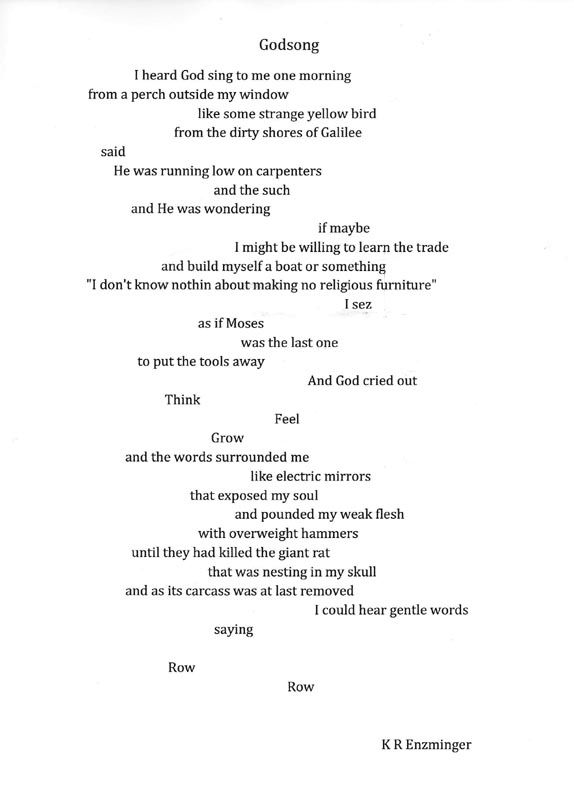![]()
![]()
![]()
![]()
![]()
![]()
![]()
![]()
![]()
![]()
![]()
![]()
![]()
![]()
![]()
![]()
![]()
![]()
![]()
![]()
![]()
|
|

The Last Rites of Saint Aloysius
1994
| SAINT
ALOYSIUS 1568-1591 St. Aloysius, or Luigi Ganzaga, was born the eldest son of Ferrante, Marquis of Castiglione, and of Marta Tana Santena, lady of honour to the wife of Phillip II of Spain. It is impossible to estimate Aloysiusís career without some idea of his appalling heredity, birthright and environment. The Gonzaga tyrants entered history about 1100 A.D. and faced the relentless peril of assassination. These despots of early history displayed an amazing mixture of qualities ranging from insane debaucheries to explosions of a genuine underlying faith. Their loyal subjects, severely bled by taxation yet thrilled by the exploits of their exotic pageantries, worshipped them until organizing a bloody but useless revolution against their rule. The Gonzaga clan were great connoisseurs of the arts, devoted to plays which the French Parliament petitioned against as being a "high school of adultery". Even the palace walls of their cliff like fortress were adorned in pictures no one would now dare print. Given these circumstances, it was fitting that his fatherís one ambition was that his first-born son should become a great soldier. At the age of seven, Aloysius experienced what may best be described as a spiritual awakening. Having been raised since babyhood to recite morning and evening prayers, Aloysius took to reciting various devotions on a daily basis, repeatedly pausing to give a "Hail Mary" at every step while climbing or descending stairs, and developed a tendency to faint at the sound of vulgar talk. At the age of twelve, he was afflicted with a painful kidney disease which provided the priggish lad with an adequate excuse for appearing little in public and devoting his time to prayer and religious literature. When Aloysius was between the ages of 13 to 15, his family accompanied the empress of Austria to Spain where, much to his fatherís intense indignation and family opposition, he unveiled his desire to become a Jesuit. Aloysius viewed himself as "a twisted iron needing to be twisted straight" and soon began to practice the austerities of a monk, fasting three days a week on bread and water, flogging himself with a dog whip and placing chunks of wood in his bed at night to ward off temptations of the flesh. He was especially wary of females and would never be alone in a room with one - not even his mother. Born of noble birth, an imperial prince and rightful heir, Aloysius was sent, upon the insistence of his father, to visit all the rulers of Northern Italy in hopes of awakening some new interest. Eminent churchmen and laymen, filled with threats and promises, were sent to dissuade him. But none could move Aloysius from his resolution to become a Jesuit. In 1585, Aloysius renounced his birthright in favor of his younger brother, Rudolfo, and was at last allowed to enter the Jesuit novitiate house of Santí Andrea on November 25, 1585. But in 1588, a quarrel broke out between two of Aloysiusís siblings. Aloysiusís father by now had died and he was called to Mantua to settle the dispute between Rudolfo and Vincent (now the Duke of Mantua and head of the clan) and it is there he was able to see his mother, whom he loved very deeply. Vincentís untimely death left Rudolfo to run riot until his exasperated vassals shot him. Aloysiusís youngest brother, Diego, was shot as well and ran to his motherís arms to die and she was stabbed and left for dead in the street but Aloysius, in a vision, cured her. There is little to be said about St Aloysius during the next two years except he proved in all respects to be an ideal novice. Being under regular discipline, his excessive desire for austerity was curbed and he was now obliged to take recreation, to eat more and to distract his mind. However, during morning prayers one day, Aloysius had the revelation that he had not long to live which filled him with joy and weaned his heart even further from the things of this world. Out of consideration for his precarious health, he was called to Rome to complete his theological course. A great epidemic fell upon Rome in 1591 and the Jesuits opened a hospital in which many members of the order rendered personal services. Although the reek made him sick and faint, Aloysius performed with zeal the lowliest duties of the hospital, heaped with dying men. Aloysius himself soon fell victim to the plague and joyously believed he was dying. Contrary to all expectations, he recovered only to later develop a low grade fever which in three monthís time reduced him to great weakness. As long as he possibly could, Aloysius would rise from his bed at night to worship his crucifix and one by one kiss his sacred pictures. Then he would kneel in prayer, propped up between the bed and the wall. Upon receiving encouragement that a person could go straight into the presence of God without passing through Purgatory, Aloysius fell into a state of ecstasy in which it was revealed he would die on the octave of Corpus Christi. Although his health had vastly improved by the octave day, Aloysius maintained that he would die before the following day. Upon Aloysiusís request, Father Bellarmine (under whose guidance he owed the development of a courageous devotion to God and the shedding of priggish attitudes to human affection) recited the prayers for the departing. After which, Aloysius lay very still, occasionally murmuring "Into thy hands". With his eyes fixed upon the crucifix and the name of Jesus on his lips, Aloysius died at approximately midnight at the age of 23. Such were the circumstances of Aloysiusís life. His life of prayer and continuous war against that pride which he knew still remained deep inside him and his day-to-day response to grace were what fitted him to be declared the patron saint of all youth in 1729. His relics now lie under the altar in the Lancellotti chapel of the church of St Ignatius in Rome; he was canonized in 1726 and continues to be one of the "Boy Saints" held up as role models by generations of Jesuits to their adolescent students. Feast day - June 21 |
|
|
|



